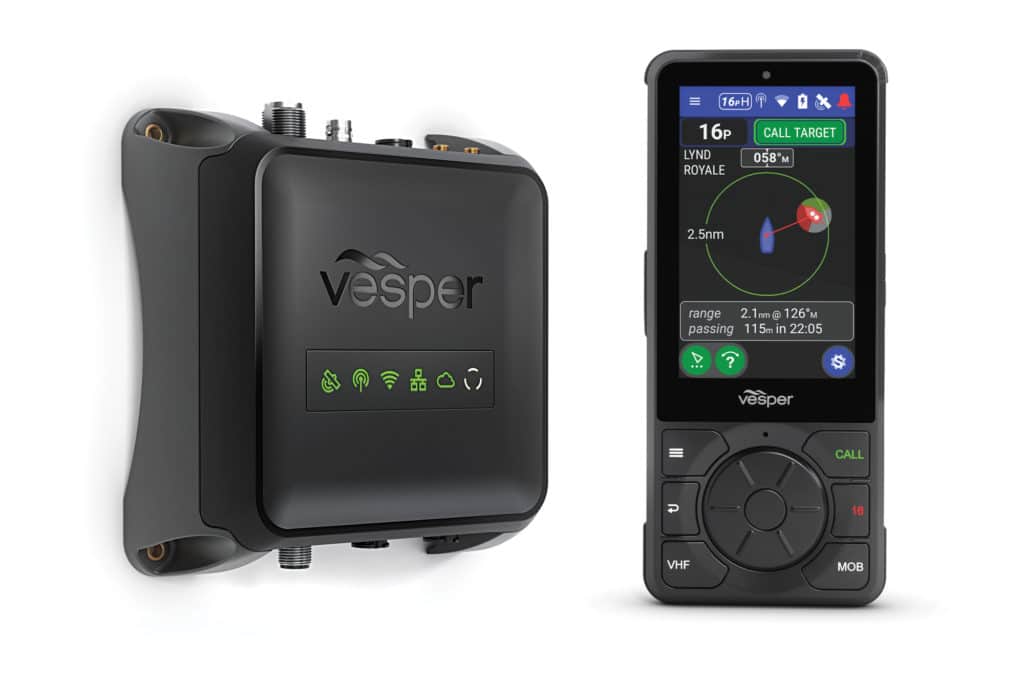
The year 2005 doesn’t feel like a long-lost horizon, but in the context of technology’s unblinking evolution, the chasm of time becomes insurmountable. That August, my then-girlfriend—now wife—and I were helping to deliver my dad’s J/44 to Maine. During a graveyard watch off Portland, I encountered a tricky situation involving a ship that my colorblind eyes couldn’t decipher. Automatic Identification System equipment didn’t exist, so I reluctantly woke our intrepid captain, and we eventually hailed the ship on VHF radio. All ended safely, but the situation illustrated the need for an integrated safety and communications platform.
Now, 14 years later, Vesper Marine’s Cortex has arrived.
Vesper Marine’s Cortex simplifies VHF radio operations and delivers AIS, cellular, Digital Selective Calling and Wi-Fi communications to a smartphone running one of two Cortex apps, or to a wireless handset. Cortex systems also have on- and off-vessel smart alarms with dedicated “situation views,” prioritizing the most-pressing concerns.
Much like Apple’s first-generation iPhone, Cortex is a ground-up platform delivering integrated, marine-specific communications in an intuitive, software-driven device. Also like iPhones, Cortex uses a highly parallel multichannel architecture and a pinch-to-zoom touchscreen interface.
Intuitive to use, Cortex is composed of an IPX7-rated, black-box M1 communications hub, two smartphone apps, and one or more optional—but recommended—H1 handsets. The M1 is mounted belowdecks with a built-in AIS B/SO transponder, an embedded SIM card for cloud connectivity, an integrated VHF radio splitter, a nine-axis sensor, a bilge-pump sensor input, NMEA 0183/2000 connectivity, dual audio ports, a battery-voltage sensor and two control outputs. The setup lets users remotely automate two onboard devices/systems, such as a masthead light, from their smartphone app.
The Cortex unit has an industrial design and all-plastic construction. “The motivation was to make it rugged,” says Jeff Robbins, Vesper Marine’s CEO. This construction uses thermal plastics and helps shed the heat that the M1’s 25-watt VHF radio generates.
Aesthetically, H1 handsets are longer, narrower and thicker than smartphones, with generously sized and optically bonded Gorilla Glass screens above six dedicated buttons (menu, back, VHF, call, Channel 16 and MOB) flanking a magnet-driven rotary wheel with a central selector button. A dedicated DSC emergency button sits atop the H1, under a protective red cover. The handsets are IPX7-rated and support one-handed, ambidextrous operations, even when wet, salty gloves are involved. Each handset communicates wirelessly with its paired M1, however, each yacht’s first H1 uses a hardwired power supply.
“Ergonomics are important,” says Carl Omundsen, Vesper’s chief technical officer. “Its rubberized treatment lets you set it down without it slipping and sliding and helps absorb [the shock from] drops.”
The H1 handset is optional and designed to remain aboard, so the system comes with two Android- and iOS-friendly apps that owners can download to smartphones that go ashore. Cortex Onboard turns a user’s phone into a closely mirrored handset that delivers most of an H1’s functionality (except for VHF radio operations) while Cortex Monitor listens for activated onboard alarms.
Once the system is networked with the yacht’s multifunction display or NMEA backbone—and with the GPS, VHF radio antenna and DC power (users can add cellular and Wi-Fi antennas)—Cortex shares all communications passing through its M1 hub with its paired H1 handset and Cortex Onboard, rendering this information as easy-to-understand graphical depictions. Users can cycle among four operating views including VHF, directory (stored DSC contacts and favorites), instruments (NMEA data) and plotter, and the system has three prioritized “situation views” for managing AIS targets, anchor-watch alarms and man-overboard emergencies.
“Alarm management always runs in the background,” Robbins says. “If an alarm comes in and a user acknowledges it, Cortex directs them to the source of the alarm. But if another vessel becomes more important, the system prioritizes this [threat].”
Unlike VHF and DSC-enabled VHF radios, Cortex handsets and the Cortex Onboard app let users call other AIS-equipped boats directly by tapping onscreen icons. Likewise, users can hail DSC contacts by tapping their name in the directory.
“We tried to hide as many knobs and settings as possible,” Robbins says.
The company took a similar, intuitive approach to updates. “We designed Cortex from the start to be easily upgradable, and all software is upgraded automatically from a user’s paired mobile device,” Robbins adds.
The system’s AIS operations are equally user-friendly, and Vesper developed its “smartAIS” concept (to prioritize AIS targets and provide alarms) with Cortex. Previously, smartAIS features were only available on board, but with Cortex’s optional cloud-monitoring service, users with the Cortex Monitor app can access real-time anchor watch, geofence, shore power, battery levels, and high-water, motion and temperature information.
Users can also access onboard alarms using Cortex Onboard or H1 and network their M1 to external speaker(s), allowing Cortex to deliver a series of intensifying audio alerts.
“We start annunciations at a normal voice that pauses and repeats its message,” says Omundsen, adding that M1s have two audio-out channels: one for the system’s soft warning and the other for mandated DSC alarms. “If this isn’t acknowledged, we start escalating.”
While there’s no comparing 2007-era iPhone use with humanity’s current—and growing—smart-screen dependence, Cortex is poised to be an onboard technological juggernaut. Because of the platform’s software-based approach, new features and capabilities can be developed and released in real time.
Best yet, Cortex could help de-escalate confusing crossing situations—without waking up Dad.









